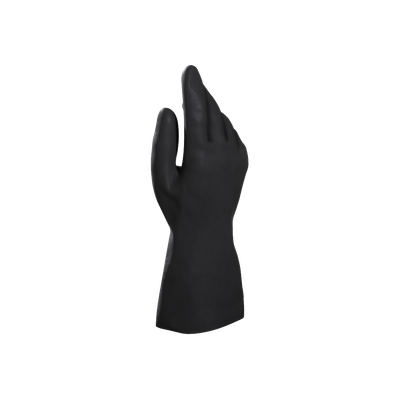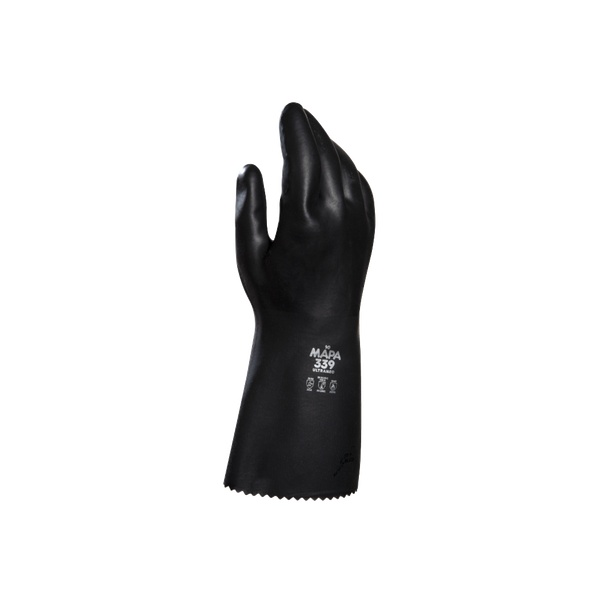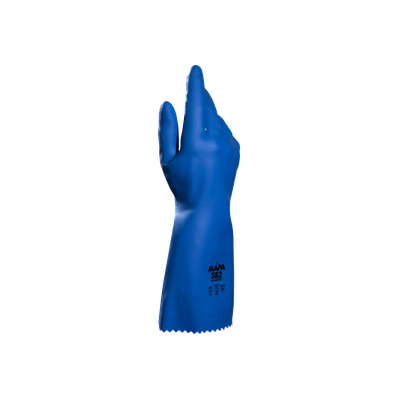UltraNeo 339
Comfort and high-level chemical protection
-
CAT. 3
 0334
0334
-
 3121X
3121X
-
Type A
 ABCJLMNS
ABCJLMNS
-
 X1XXXX
X1XXXX
Specific advantages
 Thermal protection
Thermal protection
- Thermal insulation from the cotton-knit lining for handling hot liquids
 Durability
Durability
- Excellent mechanical resistance and longer service life, due to the textile support and the thickness of the glove
 Productivity
Productivity
- Pebbled embossing, for better grip on wet and slippery objects
 Skin protection
Skin protection
- Superior chemical resistance against acids and alkalis, such as concentrated hydrofluoric acid, oils, and greases, due to its 100% neoprene multi-layer construction
 Guaranteed quality
Guaranteed quality
- Silicone free to prevent traces, defects on metal sheet and glass prior to painting
Specific features
Designed using an exclusive anatomical shape, ChemZoil gloves offer excellent fit and exceptional comfort, even when worn for long periods. The pre-curved fingers provide unrivalled freedom of movement, for this high-risk chemical protection glove.
Applications
Mechanical industry
- Surface treatment of metals (acids)
Chemical industry
- Handling and transporting drums of chemical products
- Handling on alkylation units
- Hot, petrochemical product sampling
- Resin-working
- Site pollution control
Product detail
| Material | Polychloroprene |
|---|---|
| Colour | black |
| Interior finish | Textile support |
| Exterior finish | Pebbled |
| Length (cm) | 36 |
| Thickness (mm) | 1.35 |
| Size | 9 10 |
| Packaging | 1 pair/bag 6 pairs/carton |
Chemical chart
OVERALL CHEMICAL PROTECTION RATING
Protection rating is determined by taking into account the effects of both permeation and degradation in an attempt to provide users with an overall protection guideline when using our glove products against specific chemicals.
Meaning of the colours :
The chemical test data and overall chemical protection rating should not be used as the absolute basis for glove selection. Actual in-use conditions may vary glove performance from the controlled conditions of laboratory tests. Factors other than chemical contact time
| Chemical Product | CAS # | Breakthrough time (minutes) |
Permeation level |
Standard | Degradation level |
Rating |
|---|---|---|---|---|---|---|
| 1,1,1-Trichloroethane 99% | 71-55-6 | 54 | 2 | ASTM F739 | 2 |
|
| 1,1,2-Trichlorotrifluoroethane (Freon TF or Freon 113) 99% | 76-13-1 | >480 | 6 | ASTM F739 | 4 |
|
| 1,2 - dichloroethane 99% | 107-06-2 | 30 | 1 | ASTM F739 | 1 |
|
| 1,2-Dichlorobenzene 99% | 95-50-1 | 60 | 3 | ASTM F739 | 1 |
|
| 1,2,4-Trichlorobenzene 99% | 120-82-1 | 131 | 4 | ASTM F739 | 1 |
|
| 1,3 - Dichlorobenzene 98% | 541-73-1 | 31 | 2 | ASTM F739 | 1 |
|
| 2-Butoxyethanol (Butyl Cellusolve) 99% | 111-76-2 | >480 | 6 | ASTM F739 | 4 |
|
| 2-Chlorotoluene (o-Chlorotoluene) 99% | 95-49-8 | 40 | 2 | ASTM F739 | 1 |
|
| 2-Ethoxyethanol (Cellosolve) 99% | 110-80-5 | 463 | 5 | ASTM F739 | 4 |
|
| 2-Propanol (Isopropanol) 99% | 67-63-0 | >480 | 6 | ASTM F739 | 4 |
|
| 2,2,2-Trifluoroethanol 99% | 75-89-8 | >480 | 6 | ASTM F739 | 4 |
|
| 4-Chlorotoluene (p-Chlorotoluene) 98% | 106-43-4 | 31 | 2 | ASTM F739 | 1 |
|
| Acetaldehyde 99% | 75-07-0 | 36 | 2 | ASTM F739 | 4 |
|
| Acetic acid 10% | 64-19-7 | >480 | 6 | ASTM F739 | 4 |
|
| Acetic acid 50% | 64-19-7 | >480 | 6 | ASTM F739 | 4 |
|
| Acetic acid 99% | 64-19-7 | >480 | 6 | EN 16523-1:2015 | 3 |
|
| Acetone 99% | 67-64-1 | 31 | 2 | EN 374-3:2003 | 4 |
|
| Acetonitrile 99% | 75-05-8 | 146 | 4 | EN 16523-1:2015 | 4 |
|
| Acrylonitrile 99% | 107-13-1 | 80 | 3 | ASTM F739 | 4 |
|
| Ammonium hydroxide solution 29% | 1336-21-6 | >480 | 6 | ASTM F739 | 4 |
|
| Benzene 99% | 71-43-2 | 16 | 1 | ASTM F739 | 1 |
|
| Butyl Acetate 99% | 123-86-4 | 56 | 2 | EN 374-3:2003 | 2 |
|
| Carbon disulfide 99% | 75-15-0 | 5 | 0 | ASTM F739 | 1 |
|
| Carbon Tetrachloride 99% | 56-23-5 | 55 | 2 | ASTM F739 | 1 |
|
| Chlorobenzene 99% | 108-90-7 | 17 | 1 | ASTM F739 | 2 |
|
| Chloroform 99% | 67-66-3 | 9 | 0 | ASTM F739 | 1 |
|
| Chromic Acid 50% | 7738-94-5 | 442 | 5 | ASTM F739 | 4 |
|
| Cumene 98% | 98-82-8 | 49 | 2 | ASTM F739 | 2 |
|
| Cyclohexane 99% | 110-82-7 | 204 | 4 | ASTM F739 | 4 |
|
| Dichloromethane (Methylene Chloride) 99% | 75-09-2 | 7 | 0 | ASTM F739 | 1 |
|
| Diethanolamine 97% | 111-42-2 | >480 | 6 | ASTM F739 | 4 |
|
| Dimethylformamide 99% | 68-12-2 | 92 | 3 | ASTM F739 | 3 |
|
| Dimethylsulfoxide 99% | 67-68-5 | >480 | 6 | ASTM F739 | 4 |
|
| Ethanol 95% | 64-17-5 | >480 | 6 | ASTM F739 | 4 |
|
| Ether (Diethyl Ether) 99% | 60-29-7 | 16 | 1 | ASTM F739 | 2 |
|
| Ethyl acetate 99% | 141-78-6 | 22 | 1 | EN 16523-1:2015 | 3 |
|
| Ethylene glycol 99% | 107-21-1 | >480 | 6 | ASTM F739 | 4 |
|
| Formaldehyde 37% | 50-00-0 | >480 | 6 | EN 16523-1:2015 | 4 |
|
| Furfural 99% | 98-01-1 | 208 | 4 | ASTM F739 | 4 |
|
| Hydrazine 35% | 302-01-2 | >480 | 6 | ASTM F739 | NT |
|
| Hydrochloric acid 10% | 7647-01-0 | >480 | 6 | EN 374-3:2003 | 4 |
|
| Hydrochloric acid 35% | 7647-01-0 | >480 | 6 | EN 374-3:2003 | 4 |
|
| Hydrochloric acid 37% | 7647-01-0 | >480 | 6 | ASTM F739 | 4 |
|
| Hydrofluoric Acid 40% | 7664-39-3 | >480 | 6 | EN 16523-1:2015 | NT |
|
| Hydrogen fluoride Anhydrous 99% Gas | 7664-39-3 | >480 | 6 | ASTM F739 | NT |
|
| Hydrogen fluoride Anhydrous 100% Liq. | 7664-39-3 | >480 | 6 | ASTM F739 | NT |
|
| Hydrogen peroxide 30% | 7722-84-1 | >480 | 6 | EN 16523-1:2015 | 4 |
|
| Isobutyl alcohol 99% | 78-83-1 | >480 | 6 | ASTM F739 | 4 |
|
| Kerosene mixture | 8008-20-6 | >480 | 6 | ASTM F739 | 4 |
|
| m-Cresol 97% | 108-39-4 | >480 | 6 | ASTM F739 | 4 |
|
| Methanol 85% | 67-56-1 | >480 | 6 | EN 374-3:2003 | 4 |
|
| Methanol 99% | 67-56-1 | >480 | 6 | EN 374-3:2003 | 3 |
|
| Methanol 99% | 67-56-1 | 221 | 4 | EN 16523-1:2015 | 3 |
|
| Methyl Amyl Ketone 98% | 110-43-0 | 45 | 2 | ASTM F739 | 2 |
|
| Methyl Ethyl Ketone (2-Butanone) 99% | 78-93-3 | 16 | 1 | EN 16523-1:2015 | 2 |
|
| Methylisobutylketone 99% | 108-10-1 | 50 | 2 | ASTM F739 | 2 |
|
| n-Heptane 99% | 142-82-5 | 132 | 4 | EN 16523-1:2015 | 4 |
|
| n-hexane 95% | 110-54-3 | 165 | 4 | ASTM F739 | 4 |
|
| N-methyl-2-Pyrrolidone 99% | 872-50-4 | 253 | 5 | EN 16523-1:2015 | 2 |
|
| N-N dimethyl acetamide 99% | 127-19-5 | 134 | 4 | ASTM F739 | 3 |
|
| Naphtha Heavy mixture | 68551-17-7 | >480 | 6 | ASTM F739 | 4 |
|
| Naphtha VM&P mixture | 8032-32-4 | 110 | 3 | ASTM F739 | 4 |
|
| Naphtha, Hydrotreated Heavy mixture | 64742-48-9 | >480 | 6 | EN 374-3:2003 | 4 |
|
| Nitric acid 10% | 7697-37-2 | >480 | 6 | ASTM F739 | 4 |
|
| Nitric acid 20% | 7697-37-2 | >480 | 6 | ASTM F739 | 4 |
|
| Nitric acid 40% | 7697-37-2 | >480 | 6 | ASTM F739 | 4 |
|
| Nitric acid 50% | 7697-37-2 | >480 | 6 | ASTM F739 | 4 |
|
| Nitric acid 65% | 7697-37-2 | >480 | 6 | EN 16523-1:2015 | 4 |
|
| p-dioxane (1,4-Dioxane) 99% | 123-91-1 | 65 | 3 | ASTM F739 | 2 |
|
| Petroleum Distillates Hydrotreated Light mixture | 64742-47-8 | >480 | 6 | ASTM F739 | 4 |
|
| Phenol 85% | 108-95-2 | >480 | 6 | ASTM F739 | 4 |
|
| Phosphoric acid 75% | 7664-38-2 | >480 | 6 | ASTM F739 | 4 |
|
| Phosphoric acid 85% | 7664-38-2 | >480 | 6 | ASTM F739 | 4 |
|
| Potassium Hydroxide 50% | 1310-58-3 | >480 | 6 | ASTM F739 | 4 |
|
| Pyridine 99% | 110-86-1 | 55 | 2 | ASTM F739 | 2 |
|
| Sodium hydroxide 20% | 1310-73-2 | >480 | 6 | EN 374-3:2003 | 4 |
|
| Sodium hydroxide 40% | 1310-73-2 | >480 | 6 | EN 16523-1:2015 | 4 |
|
| Sodium hydroxide 50% | 1310-73-2 | >480 | 6 | EN 374-3:2003 | 4 |
|
| Sulfuric acid 10% | 7664-93-9 | >480 | 6 | ASTM F739 | 4 |
|
| Sulfuric acid 40% | 7664-93-9 | >480 | 6 | ASTM F739 | 4 |
|
| Sulfuric acid 50% | 7664-93-9 | >480 | 6 | ASTM F739 | 4 |
|
| Sulfuric acid 96% | 7664-93-9 | 450 | 0 | EN 16523-1:2015 | 3 |
|
| Tetrachloroethylene (Perchloroethylene) 99% | 127-18-4 | 23 | 1 | ASTM F739 | 2 |
|
| Toluene 99% | 108-88-3 | 12 | 1 | EN 16523-1:2015 | 1 |
|
| Triethanolamine 98% | 102-71-6 | >480 | 6 | ASTM F739 | 4 |
|
| Unleaded gasoline mixture | 8006-61-9 | 47 | 2 | ASTM F739 | 2 |
|
| Vinyl Chloride 99% | 75-01-4 | >480 | 6 | ASTM F739 | NT |
|
| Xylene 99% | 1330-20-7 | 34 | 2 | ASTM F739 | 1 |
|
*not normalized result
More gloves

UltraNeo 420
Extremely supple with freedom of movement for standard chemical protection

Alto 260
A good choice when dexterity and chemical protection is needed for extended wear








